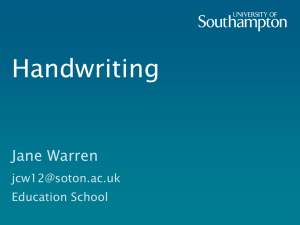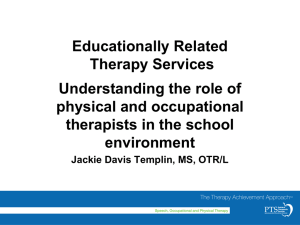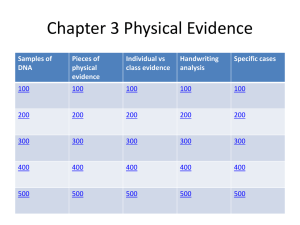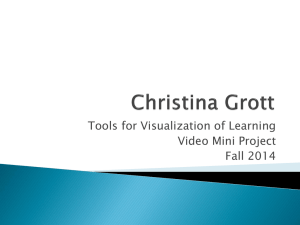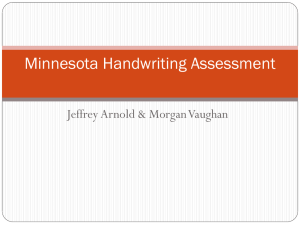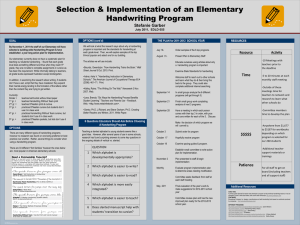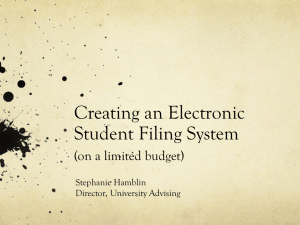Handwriting PowerPoint
advertisement
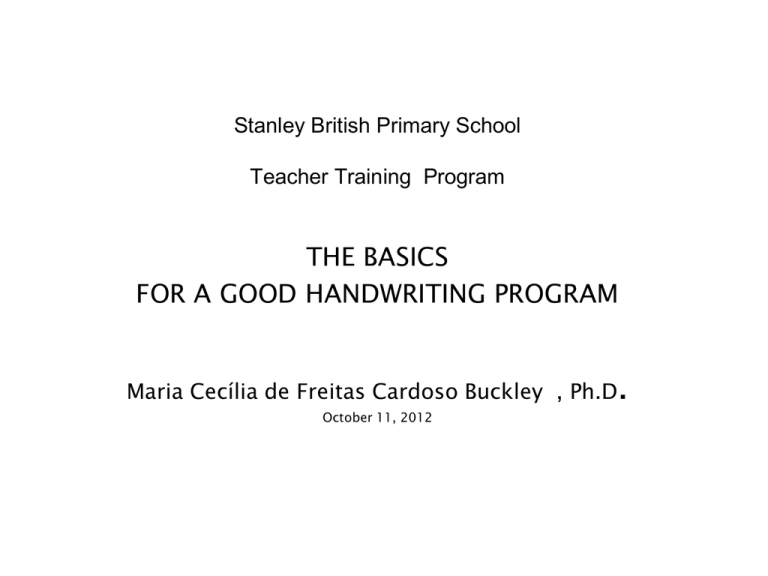
Stanley British Primary School Teacher Training Program THE BASICS FOR A GOOD HANDWRITING PROGRAM Maria Cecília de Freitas Cardoso Buckley , Ph.D. October 11, 2012 Why teach handwriting??? • Students need a legible, fluent style of handwriting to fully participate in writing. • Handwriting fluency predicts how much and how well children write. • Attention to motor skills strains students’ processing capacity that could be used for higher order skills (keeping up with own thoughts, planning, content generation, revisions…) • Overtime children may minimize other writing processes, avoid writing or believe they cannot write. • Handwriting accounts for how writing is evaluated. • Note taking and adult use are still necessary. 2 • Many problems can be prevented by early training. • Young children in kindergarten and early grades should learn to form letters correctly. • Kinesthetic memory is powerful and incorrect habits are very difficult to eradicate 3 Goals • Automaticity – No need to use working memory to “draw” the letters.. • Speed and rhythmicity -> Higher order skills – Fluency of writing; fluency of thoughts • Legibility -> communication – – – – – – Letter formation Letter spacing Letter alignment Letter size Letter slant Word spacing 4 What to teach? 5 Graphomotor skills • They are: – Complex skills – Specific skills • They require – Skilled coordination 6 Foundational Skills • • • • • • • • • • • • Gross Motor Efficacy Fine Motor Stabilization Visual Perception and Visual Memory Spatial Perception and Spatial Memory Sequencing Figure Ground Eye-Hand Coordination Motor memory Symbol Formation Perceptual Motor integration Sensory integration Graphomotor skills (including Memory, Production, Feedback) 7 Basic Movements – Top -> down (manuscript: capitals, most lower case letters) – Left-> right – Counter clock, starting at 1:00 (all “c” letters) – Special “e” – “Trace yourself” (parts of letters that go up and down) 8 • Spatial awareness, spatial perception, spatial memory, spatial output – – – – – Whole body Arm Hand Fingers Distal joints 9 Posture – Best posture for handwriting (with feet on the ground or on phone books…) – Both elbows on the table – Use of “helping hand” to hold the paper – Stabilization of paper – Distance from eyes to paper (more than 5 inches) 10 Grip – Tripod: pencil held between thumb and index finger and resting on other fingers – Consistency of grip – Distance from finger to point (3/4 to 1 inch) – Pressure – Angle of pencil (45º) – Position of wrist (slight extension) – Position of thumb (forefinger-thumb opposed) – Movement of joints (mostly distal joints) 11 “Finger Training” Foundational skills for prevention and remediation - use the fingers (not wrist/hand/arm) • • • • • • • • Spirals in the air / on the table / on paper Feed the baby bird Flying bird at transitions Pull in - push away on paper Spider on a rod Pick up objects with chopsticks Finger aerobics Pick up small objects with fingers and collect them in the hand / throw them away one by one 12 Teaching Print • Upper case letters – – – – Same height Start on the top Easy to recognize and identify Groups of letters: • • • • I, E, F, L, H, T D, B, P, R C, O, G, Q, J, S, U K, M, N, A, V, W, X, Y, Z – As soon as possible write words and sentences. (Work on spacing within words and between words) 13 • Lower case letters – Attention to size and position in space – Attention to “regular size”, “tall letters” and “diving letters” – Groups of letters: • • • • • Letters students already know: c, o, s, v, w, x, z “c family” letters: c, a, d, g, q, o “tall letters”: t, l, f, k, h, b “special letters” bumps, curves, dot: m, n, r, i, u, s, e “diving letters”: p, j, y, q 14 Teaching Cursive • Lower case – – – – All letters start on the line All letters are linked First write all the letters, than go back to dot and cross Groups of letters: • • • • • • • “c family”: c, a, d, o, g, “i family”: i, t, u, j, y “bump family”: m, n “loop family”: e, l, h, k, f “in and out family” (or little loop family): b, v, w “tricky ones”: r, s, x “divers”: q, z, p 15 Sample 16 • Upper case – Almost all start on the top – They are pretty “independent and snobbish” most do not like to connect with the rest of the word and like to have fancy lines – Order of presentation • It really does not matter at this point • I like to start with the child’s name 17 Sample 18 How to teach??? 19 There is no “best” method… -> There are best practices!!! A systematic, progressive, multisensory approach that Uses all 7 senses… Uses verbalization… Uses verbal, visual and kinesthetic feedback.. Uses mnemonics…little stories, rhythm, songs… Make it fun !!!!!! 20 Best practices… Explain… Demonstrate… Offer opportunity for: observation and imitation (see and do) tracing (with fingers, to get the gestalt for proper movement) copying (always BELOW the sample) writing (no visual cues, may use oral cues) Give opportunity for self evaluation… Give opportunity for guided, supervised learning experience… Make handwriting useful (post cards, letters, lists, notes…) 21 It is important to have – Formation of mental image of features and of HOW it is formed (this CANNOT be inferred from a still model presented in a worksheet or copybook) – Guided exposure – Mental response from child concerning the formational process, not just motor response (there is a need for cognitive engagement) – Emphasis on comparison and improvement rather than writing numerous samples 22 Extensive use of unsupervised writing or copy work as an independent activity until the child has developed good handwriting habits can have detrimental effects. 23 How about discovery? • Discovery is NOT an effective approach. • Handwriting is best taught in frequent (daily is best) specific brief periods of direct instruction and supervised practice. 24 Integrating with reading… • • • • Letter name Letter keyword Letter sound Letter formation Teach together!!!!!!! 25 a A u a, apple, /a/ 26 Teaching Strategies • Direct Instruction – – – – Explanation Demonstration Presentation of model Imitation • Guided Practice – Cues, prompts, approximation (with correct movement) • Self-evaluation 27 Three specific skills • Trace – Air, just in front of model, vertical plane, use three fingers (stronger neurological input for muscle memory) – Vertical plane – Horizontal plane – Distal joints movement • Copy – Air / vertical / inclined (“binder technique…”/ horizontal • Write – Air / vertical / inclined (“binder technique…” / horizontal 28 Start with whole body movement!!! 29 Write letters with your arm Use your body to introduce concepts: Tall letters Middle size letters Letters that go deep 30 My four main approaches… • “Moving Around” • “Sound System” • “Messy Work” • “Write on paper” 31 “Moving Around” – Warm up with gross motor, whole body activity. Quiet down with sensory input (all 7 senses) – Write with body – Use of vertical plane – Use of horizontal plane on the ground – Write in the air (thumb, index and middle pointing out) – Cross midline exercises – From perception of letters to writing: • • • • Write with the whole body Write with the arm Write with the fingers Write using distal joints (nothing substitutes this - it needs lots 32 of practice!!!) “Sound System” – EXTENSIVE use of rhythm, poetry, pitch, music and songs – “Talk it out” - describe the movements of the stroke while writing the letter • (example:“down, back up, round up” for manuscript lower case “b”) – Count the lines (using rhythm) • (example: “one, two” for capital manuscript L) 33 “Messy Work” Use: – – – – – – Shaving cream, toothpaste, hair gel… Paint… Sand, corn meal, salt… Sidewalk chalk, chalk on dark paper… Sand paper… Letters with glue to trace… 34 Write on paper • “Worksheets” – – – – Lines and curves Mazes “Correct the Teacher” games Find shapes, position in space, patterns, proportion… • Use variety of writing instruments (pencils, pens, thin markers, pieces of crayon…) – Discover what is most appropriate for each child. – Use grip helpers if necessary. • Trace, copy, write • Speed drill • Transposition from print to cursive 35 Supervision and Evaluation • DURING writing: – Supervision is crucial until letter is mastered. – Attention to movements/strokes/grip as important as the final product during learning • AFTER writing: – Child evaluates own work • Comparison to model (Anything needs improvement?) • Comparison to own work (choosing best letter, making corrections) 36 Tips • Vertical letters are easier than slanted letters. There is no need to teach slant. • “Bad practice” can make handwriting worse. • Avoid mindless, boring repetition. 37 About copying • To copy from a model above is easier than copying from model on the left • Only one copy from each model • Tip: use sight/frequent words or patterns you are studying boat bat there ______________ __________ ______________ 38 When to teach??? • • • • • When teaching letter name, sound Every day Very small groups Few minutes of supervised work “Little practice, constant review” 39 Which paper to use??? • Special lined paper – – – – – With dotted line With elevated lines for sensory tactile input With visual cues With different widths to help decrease the letter size With a fourth bottom line to help with the “divers”. • Regular paper – Use different widths -> SKIP A LINE !!! 40 Development of Basic Skills • Visual perception – Discrimination, figure ground… • Find similarities and differences… • Find an object among other objects… • Attention to very fine details… • Fine motor skills – Manipulation of small objects… • • • • • Construction with pebbles, sand, small blocks… Cut and tearing different materials using fingers… Use of tweezers and chopsticks… Beads on strings… Sand, play dough, clay, cookie and bread dough… 41 • Visual Motor Skills – Activities that use vision to guide motor activities. • Walk following a line on the floor • Cut on the line • Trunk Control – Activities on tummy on the floor (coloring, drawing, playing with blocks..) – Animal walks (tummy up and tummy down) • Shoulder Stability – Draw or color paper on vertical surface or chalkboard. – Play games while staying on hands and knees. 42 It requires maturation… • Maturation takes time… • Children have different rhythms… • Children with specific learning disabilities may take much longer than most children to achieve neurological maturation and require even more exposure to experiences that favor development of specific skills. 43 However… Not all children will be able o acquire good handwriting skills… Some people couldn’t care less… Some children will need the use of computer technology and specific adaptations or modifications very early at elementary grades (scribe, oral answers, dictation into mini tape recorders, oral presentations etc…). 44 A word about Assistive Technology • It is here to stay… • It will only get better… • Some students will depend on it… 45 Teaching “Lefties” • Position paper completely on the left side of child’s midline. • Angle paper to be parallel to the child’s forearm (about 45º). • Teach child to position paper themselves. • Affix tape on table to help establish correct positioning. • Do not allow a “hooked grasp” nor holding the pencil between thumb and all four fingers along the shaft. • Please understand it is difficult to visually monitor handwriting since the hand covers the writing. 46 In synthesis… • • • • • • • • • Integrate with reading! Make it fun, make it useful… Aim for approximations (with correct movements…) Use multisensory approach using all 7 senses… Use demonstration, explanation, imitation, tracing, copying, writing, guided practice… Promote frequent, little, correct practice… Copy from above, one copy per model… Use vertical, inclined and horizontal planes… Use “whole body to distal joints” approach… 47 Some resources • The International Dyslexia Association. Just the Facts… Dysgraphia. Fact Sheet #82 - 01/00 • ERIC DIGEST, Six Questions Educators Should Ask before Choosing a Handwriting Program. 1997 by the ERIC Clearinghouse on Reading, English and Communication. • Hepplewhite, Debie. The Importance of Joined Handwriting. http://rrf.org.uk/46%20The%20Importance%20of%20Joined%20Han writing.htm • Stout, Kathryn L. How to Teach Handwriting. http://www.designastudy.com/teaching/tips-1198.html • Miller, Samuel. Teaching Handwriting Helps Students Achieve. i.e. information for teachers. http://www.sraonline.com/download/cwp/cursive_writing_singles1.pdf • Karl, Koenke. Handwriting Instruction: What do we know? http://www.ericae,net/db/edo/ED272923.htm 48 • • • • • Hoppes, Steve. Handwriting and Occupational Therapy - Handwriting without tears. http://moon.ouhs.edu/gshart/Steve’s%20handwriting_and_occupational_the.ht m Wesson, Kenneth. From Synapses to Learning: Understanding Brain Processes. Faculty Guidebook: A Comprehensive Tool for Improving Faculty Performance. Child Development Institute. http://www.brainsconsiderate.com Marnel, Lisa J. Handwriting For Kids. Handwriting Help for Kids.com Http://www.handwritinghelpforkids.com/basics.html Fisher, Phyllis E. Making Handwriting Flow. Using Models and Drills for Fluency. 2001. Oxton House Publishers. Olsen, Jan Z. Handwriting Without Tears curriculum. 49

